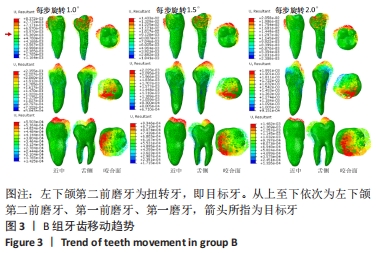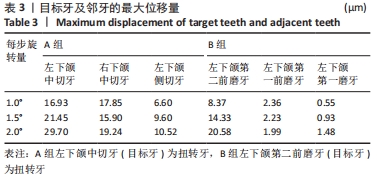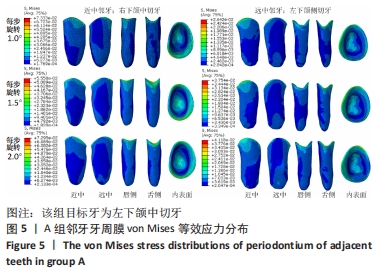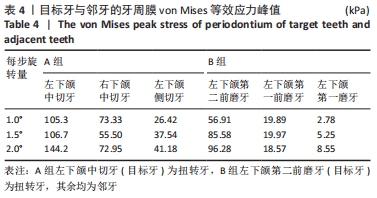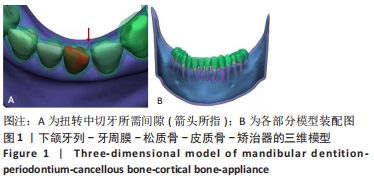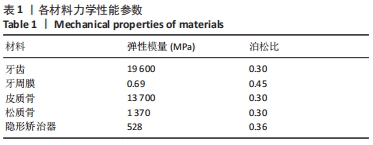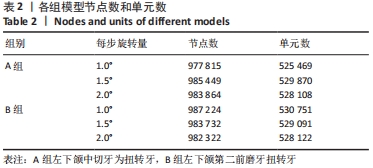中国组织工程研究 ›› 2023, Vol. 27 ›› Issue (7): 1050-1054.doi: 10.12307/2023.073
• 组织工程口腔材料 tissue-engineered oral materials • 上一篇 下一篇
无托槽隐形矫治器治疗下颌不同形态扭转牙的三维有限元分析
李惠琴1,王春娟2,王 禹1,王伟峰3,陈定根3,李 娜3
- 1川北医学院口腔医学系,四川省南充市 637000; 2口腔疾病与生物医学重庆市重点实验室,重庆市高校市级口腔生物医学工程重点实验室,重庆市 401147;3川北医学院附属医院丝绸路口腔门诊,四川省南充市 637000
Clear aligner orthodontic therapy of rotated mandibular teeth with different shapes: a three-dimensional finite element analysis
Li Huiqin1, Wang Chunjuan2, Wang Yu1, Wang Weifeng3, Chen Dinggen3, Li Na3
- 1Department of Stomatology, North Sichuan Medical College, Nanchong 637000, Sichuan Province, China; 2Chongqing Key Laboratory of Oral Diseases and Biomedical Sciences, Chongqing Municipal Key Laboratory of Oral Biomedical Engineering of Higher Education, Chongqing 401147, China; 3Department of Stomatology, Sichou Road, Affiliated Hospital of North Sichuan Medical College, Nanchong 637000, Sichuan Province, China
摘要:
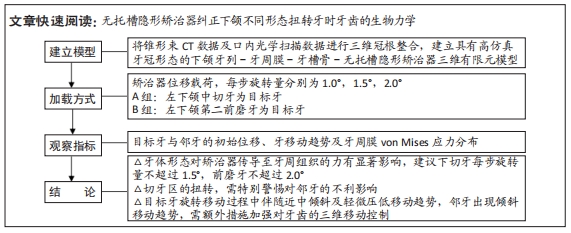
文题释义:
无托槽隐形矫治器:一种计算机辅助设计和制作的透明弹性塑料可摘式矫治器,该矫治器贴合于牙冠表面,利用膜片的弹性改变对牙齿施加矫治力,从而使牙齿发生移动。
有限元分析:利用数学近似的方法对真实物理系统进行模拟,可将一个连续体离散为有限个单元,计算加载模型任意部位的应力、应变和位移情况。
背景:旋转移动是无托槽隐形矫治中最难以预测的牙齿移动方式之一,牙体形态可影响牙齿去扭转的矫治效果,目前尚无相关的生物力学研究。
目的:探讨无托槽隐形矫治器纠正下颌不同形态扭转牙时每步旋转量设计对牙齿生物力学的影响。
方法:选择1例伴下颌中切牙及第二前磨牙扭转的成人患者,获取其锥形束计算机断层扫描数据及口内光学扫描数据,建立具有高仿真牙冠形态的下颌牙列、牙周膜、牙槽骨及无托槽隐形矫治器三维有限元模型,分析矫治器在3种不同旋转量设计(1.0°,1.5°,2.0°)下纠正扭转左下颌中切牙(A组)、第二前磨牙(B组)时,目标牙与邻牙的初始位移、牙移动趋势及牙周膜von Mises应力分布。
结果与结论:①在不同旋转量加载下,A组目标牙的位移量及牙周膜应力值均明显高于B组,增加无托槽隐形矫治器的每步旋转量可在一定程度上提高目标牙的矫治效率,但相应牙周组织损伤风险亦增加,建议下切牙每步旋转量不超过1.5°,前磨牙不超过2.0°;②A组近中邻牙的最大位移量可达目标牙的65%-105%,对于切牙区的扭转,需特别警惕对邻牙的不利影响;③目标牙在旋转移动过程中伴随近中倾斜及轻微压低移动趋势,邻牙出现倾斜移动趋势,需额外措施加强矫治器对牙齿的三维移动控制。
https://orcid.org/0000-0001-8479-583X (李惠琴)
中国组织工程研究杂志出版内容重点:生物材料;骨生物材料;口腔生物材料;纳米材料;缓释材料;材料相容性;组织工程
中图分类号:

